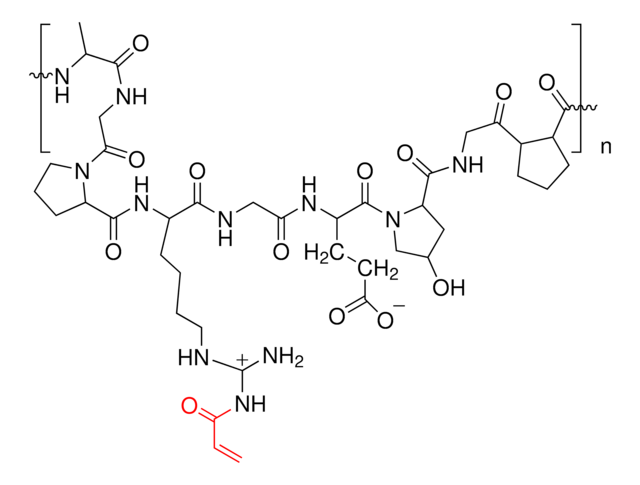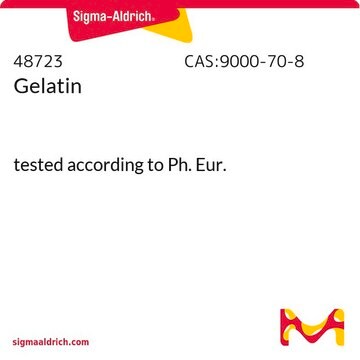900741
Gelatin methacryloyl
gel strength 170-195 g Bloom, degree of substitution: 60%
Synonym(s):
GelMA, Gelatin methacrylamide, Gelatin methacrylate, GelMa, Gelatin Methacrylate
Sign Into View Organizational & Contract Pricing
All Photos(2)
About This Item
Linear Formula:
(C40H59N11O13)n
UNSPSC Code:
12162002
NACRES:
NA.23
Recommended Products
Looking for similar products? Visit Product Comparison Guide
Application
Gelatin methacrylate can be used to form cross-linked hydrogels for tissue engineering and 3D printing. It has been used for endothelial cell morphogenesis, cardiomyocytes, epidermal tissue, injectable tissue constructs, bone differentiation, and cartilage regeneration. Gelatin methacrylate has been explored in drug delivery applications in the form of microspheres and hydrogels.
Storage Class Code
11 - Combustible Solids
WGK
WGK 3
Flash Point(F)
Not applicable
Flash Point(C)
Not applicable
Certificates of Analysis (COA)
Search for Certificates of Analysis (COA) by entering the products Lot/Batch Number. Lot and Batch Numbers can be found on a product’s label following the words ‘Lot’ or ‘Batch’.
Already Own This Product?
Find documentation for the products that you have recently purchased in the Document Library.
Customers Also Viewed
Facile one-step micropatterning using photodegradable methacrylated gelatin hydrogels for improved cardiomyocyte organization and alignment.
Tsang K, et al.
Advances in Functional Materials, 25(6), 977-986 (2015)
Photocrosslinkable gelatin hydrogel for epidermal tissue engineering.
Zhao X, et al.
Advanced Helathcare Materials (2015)
Covalent attachment of a three-dimensionally printed thermoplast to a gelatin hydrogel for mechanically enhanced cartilage constructs.
Boere KWM, et al.
Acta Biomaterialia, 10(6), 2602-2611 (2014)
Jason W Nichol et al.
Biomaterials, 31(21), 5536-5544 (2010-04-27)
The cellular microenvironment plays an integral role in improving the function of microengineered tissues. Control of the microarchitecture in engineered tissues can be achieved through photopatterning of cell-laden hydrogels. However, despite high pattern fidelity of photopolymerizable hydrogels, many such materials
Preparation and characterization of gelatin-poly(methacrylic acid) interpenetrating polymeric network hydrogels as a pH-sensitive delivery system for glipizide.
Gupta NV, et al.
Indian Journal of Pharmaceutical Sciences, 69(1), 64-68 (2007)
Our team of scientists has experience in all areas of research including Life Science, Material Science, Chemical Synthesis, Chromatography, Analytical and many others.
Contact Technical Service











